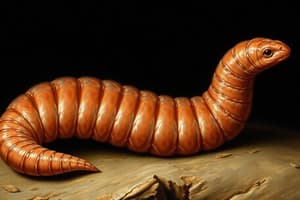Podcast
Questions and Answers
What distinguishes the Eumetazoa from the Parazoa?
What distinguishes the Eumetazoa from the Parazoa?
- Eumetazoa lack a digestive system while Parazoa have a complete gut
- Eumetazoa have differentiated tissues while Parazoa lack tissues (correct)
- Eumetazoa are sessile while Parazoa have motility
- Eumetazoa have radial symmetry while Parazoa have bilateral symmetry
How do sponges (Phylum Porifera) feed?
How do sponges (Phylum Porifera) feed?
- By extending tentacles to capture prey
- By releasing cnidocytes to sting and capture prey
- Through phagocytosis by choanocytes lining the spongocoel (correct)
- By extending a lophophore to filter feed
Which of the following best describes the body plan of cnidarians?
Which of the following best describes the body plan of cnidarians?
- Triploblastic with radial symmetry and a true coelom
- Triploblastic with bilateral symmetry and a pseudocoelom
- Diploblastic with radial symmetry and a gastrovascular cavity (correct)
- Diploblastic with bilateral symmetry and a complete digestive system
What is the distinguishing feature of the Ecdysozoa clade?
What is the distinguishing feature of the Ecdysozoa clade?
Which of the following statements about the phylum Acoela is correct?
Which of the following statements about the phylum Acoela is correct?
How do sponges (Phylum Porifera) reproduce?
How do sponges (Phylum Porifera) reproduce?
Which of the following statements about sponges (Phylum Porifera) is correct?
Which of the following statements about sponges (Phylum Porifera) is correct?
What is the primary function of choanocytes in sponges?
What is the primary function of choanocytes in sponges?
Which of the following is a characteristic of the Radiata group?
Which of the following is a characteristic of the Radiata group?
What is the primary function of cnidocytes in cnidarians?
What is the primary function of cnidocytes in cnidarians?
Which of the following phyla is characterized by a trochophore larva or lophophore feeding structure?
Which of the following phyla is characterized by a trochophore larva or lophophore feeding structure?
Which of the following statements about the Ecdysozoa clade is correct?
Which of the following statements about the Ecdysozoa clade is correct?
Which of the following statements about Acoela is correct?
Which of the following statements about Acoela is correct?
What is the primary function of the spongocoel in sponges?
What is the primary function of the spongocoel in sponges?
Which of the following statements about cnidarians is correct?
Which of the following statements about cnidarians is correct?
Which of the following statements about the embryology of the Bilateria clade is correct?
Which of the following statements about the embryology of the Bilateria clade is correct?
Flashcards are hidden until you start studying
Study Notes
Kingdom Animalia
- Kingdom Animalia is divided into two groups: Parazoa (animals lacking tissues) and Eumetazoa (true animals with differentiated tissues)
- Both groups likely evolved from a common ancestor that resembled modern-day choanoflagellates
Phylum Porifera - Sponges
- Sponges are the simplest of all animals
- They are aquatic, asymmetrical, and lack true tissues
- Adults are sessile, but larvae have motility
- Features:
- Osculum: opening for water expulsion
- Spongocoel: central cavity
- Choanocytes: collar cells that direct water through the sponge to trap and ingest food via phagocytosis
- Spicules: skeletal spikes of silica
- Lack digestive, respiratory, circulatory, reproductive, or nervous system
- Reproduction:
- Asexual: fragmentation or budding
- Sexual: differentiation of amboecytes; monoecious/hermaphroditic
Animal Phylogeny
- Eumetazoa are divided into two major groups based on embryology:
- Radiata: radial symmetry (includes Cnidaria and Ctenophora)
- Bilateria: bilateral symmetry (includes all other animals)
Phylum Ctenophora
- Comb jellies
- Eumetazoa, radiata
- Features:
- Diploblastic
- Lack cnidocytes
- Complete gut: mouth and anus
Phylum Cnidaria
- Stinging animals
- Eumetazoa, radiata
- Features:
- Diploblastic
- Endoderm: lines digestive cavity
- Ectoderm: epidermis
- Primitive nervous system: nerve net
- Incomplete digestive system: gastrovascular cavity
- Cnidocytes: specialized cell type for stinging; contain nematocysts
- Reproduction:
- Asexual: budding
- Sexual: release of gametes into the water
- Carnivorous
- Body plans:
- Polyp: sessile, asexual
- Medusa: dimorphic, sexual
- Class names:
- Anthozoa: corals, sea anemones; polypoid
- Scyphozoa: marine jellies; medusa
- Cubozoa: box jellyfish; true eyes
- Hydrozoa: both polyp and medusa forms
Animal Phylogeny (continued)
- Bilateria are divided into two major clades, also based on embryology:
- Protostomes: further divided into two major clades
- Lophotrochozoa: either have a trochophore larva and/or lophophore (feeding structure)
- Ecdysozoa: molt their exoskeleton (ecdysis); include Arthropoda and Nematoda
- Deuterostomes: include echinoderms and chordates
- Protostomes: further divided into two major clades
Phylum Acoela
- Eumetazoa, bilateria
- Features:
- Triploblastic
- Not a protostome or deuterostome
- Blastopore closes during development
- Simple nervous system differs from Platyhelminthes
- Nerve net
- Lack digestive tract: absorbs nutrients across surface
- Embryonic development is unique: one cell divides into two cells each of which then divide into more cells
- Very slight cephalization
Studying That Suits You
Use AI to generate personalized quizzes and flashcards to suit your learning preferences.




